
When I worked as a journalist, one of the hardest things I had to do throughout the entire writing process was write headlines and headings. Not only did I struggle with crafting a headline that would get readers interested in my article — which is hard enough — but I couldn’t remember proper AP headline capitalization to save my life.
Fortunately, I had patient editors who were willing to work with me to help me understand and remember how to write quality headlines every time.
Some people, however, are not so lucky, which is why I’ve written this complete guide to headline capitalization — including headline writing styles, basic headline capitalization principles, and some great tools we use at CoSchedule to write great headlines that convert and get clicks.
Let’s get started!
Understanding Different Headline Writing Styles
As my former editors would tell you, style is not everything; consistency is everything. Understanding headline capitalization styles will enable you to create your own style manual to inform how you write your headlines and keep yourself consistent across all your content.
A great guide for writing headlines across styles is this
compilation of style guides from across sources, but here are a few styles you can use to inform your own guide.
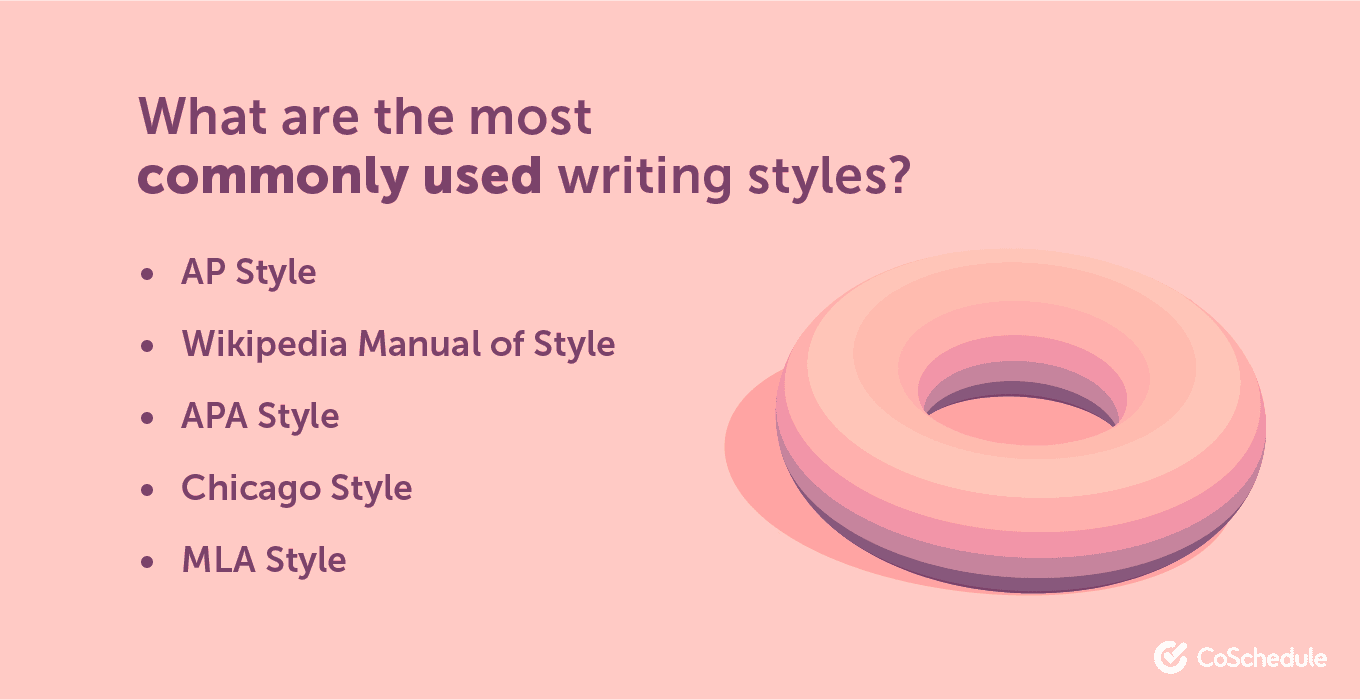
AP Style
AP Style is the preferred writing style for most journalists and news media organizations. The Associated Press Stylebook is updated yearly and is the complete guide to news writing styles, format, punctuation, word choice, and any other aspect of media writing.
AP Style is designed to ensure consistent, uniform writing and ease of understanding across channels. The AP Stylebook is a long and very detail-oriented book, but this
AP Style Cheat Sheet is designed to make AP Style a little easier to understand.
Wikipedia Manual of Style
The
Wikipedia Manual of Style is the style manual for all Wikipedia articles. It was created in order to ensure that all volunteer editors for Wikipedia use consistent language, style, and format throughout the Wikipedia platform.
Because Wikipedia strictly enforces these guidelines across its platform, its user-generated content stays consistent and Wikipedia’s content oversight board doesn’t have to get involved in format editing within its pages. This is a textbook example of the effectiveness of a quality style manual applied to a broad range of content.
Go read through some of the aspects of this style manual. Do you have that sort of consistency across your content? If not, it’s time to get to work on a style guide for your channels.
Academic style (APA, Chicago, MLA)
For our purposes, these academic writing styles are not that valuable to go over, but in the interest of making this a complete guide, I will give a brief overview of what they are.
- APA Style: The official style of the American Psychological Association, mainly used for research papers within the social sciences.
- Chicago Manual of Style: Mainly used for research papers within business, history, and fine arts. One main component of Chicago style is the use of footnotes throughout the paper — referring readers to the bibliography of the paper.
- MLA Style: MLA stands for the Modern Language Association. This style is designed to guide student research papers and is one of the most commonly used styles in academia. It mainly concerns itself with writing mechanics, like quotation, punctuation, and citation of sources.
Basic Principles of Writing Headlines in AP Style
Under AP Style:
- Capitalize only the first word of your headline and all proper nouns or abbreviations; all other words should be lowercase (e.g. “The people making North Dakota’s future bright”).
- Use numerals for all numbers (e.g. “3 ways to write headlines” as opposed to “Three ways to write headlines”).
- Use single quotes for quotation marks in headlines (e.g. “Why Joe said ‘no’”).
For more on AP Style:
Purdue Online Writing Lab (OWL): AP Style
Basic Principles of Writing Headlines in Wikipedia Manual of Style
Wikipedia Manual of Style relies on sentence case for article titles and headings. This generally means capitalizing the first word in the headline and proper nouns while all other words remain lowercase.
Wikipedia Manual of Style article title example: "Article titles, sections, and headings"
Basic Principles of Writing Headlines in APA Style
Title case is recommended in APA Style for in-text titles, all heading levels, paper headlines, periodical titles, figure titles, and table titles. It is useful as a solid separator between text and acts as a signpost for readers by setting apart the most important words, so they catch the reader’s eye as they are skimming through content.
Sentence case is recommended in APA Style for titles within reference list entries, table headings, and figure notes.
Basic Principles of Writing Headlines in Chicago Manual of Style
For titles of works such as books, the Chicago Manual of Style follows title case principles. Capitalize all nouns, pronouns, and conjunctions; and the last word of the title. Prepositions are typically lowercase.
Chicago Manual of Style title example: "A River Runs through It"
Basic Principles of Writing Headlines in MLA Style
MLA Style follows title case principles.
Basic Principles of Writing Headlines in Title Case
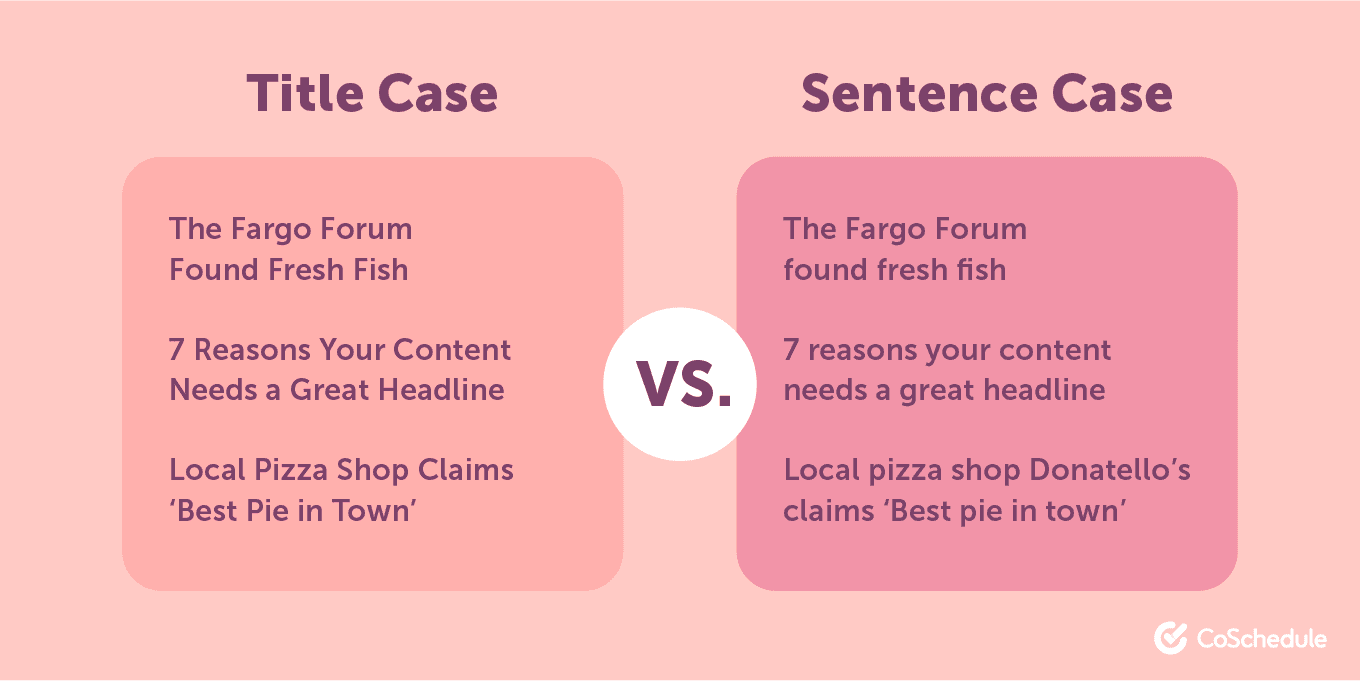
Title case headline examples:
- The Fargo Forum Found Fresh Fish
- 7 Reasons Your Content Needs a Great Headline
- Local Pizza Shop Claims 'Best Pie in Town'
When writing title case headlines,
major words are capitalized while
minor words are lowercase.
- Major words are nouns, verbs, adjectives, pronouns, adverbs, and basically any word four letters or longer.
- Minor words are conjunctions that are three letters or less (e.g. and, or, nor, but), short prepositions (at, by, for, in, of, on), and all articles (a, an, the).
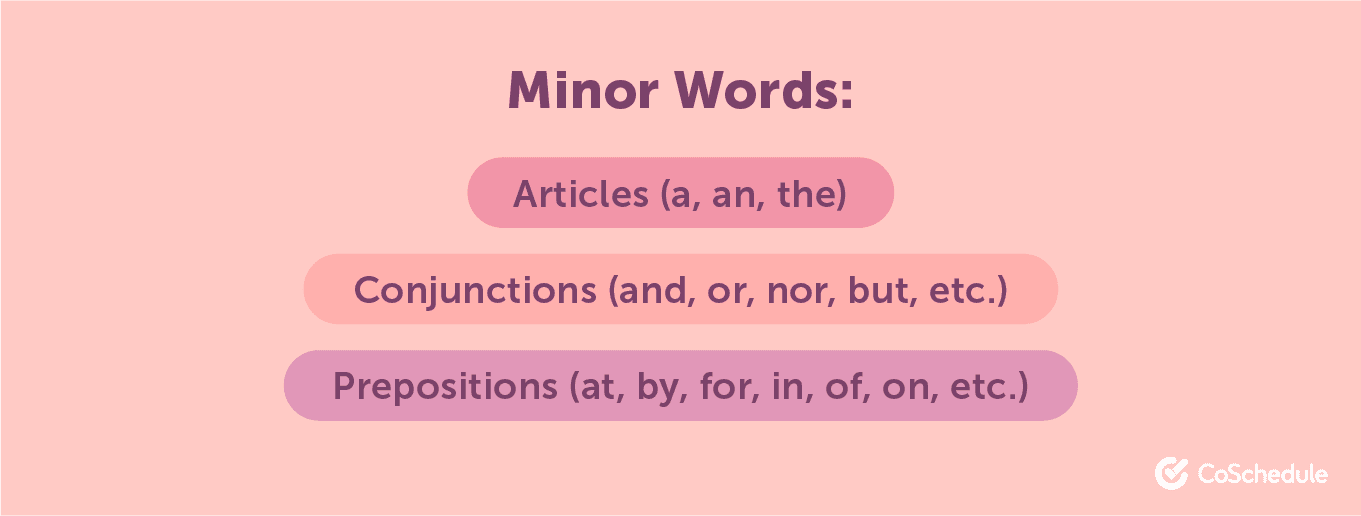
In addition, the following words should be capitalized under title case:
- The first word of the title — including minor words.
- The first word after any punctuation (semicolon, em dash, end punctuation, etc.) except for commas.
- Words four letters or longer (With, After, Then, etc.).
- All major words — including post-hyphen words (“Last-Minute” as opposed to “Last-minute”).
Basic Principles of Writing Headlines in Sentence Case
In sentence case, most words are going to be lowercase except for:
- The first word in the title/heading/subtitle
- Proper nouns
- The first word after an em dash, semicolon, or end punctuation
- Any noun followed by letters or numbers
What Headline Style is Best for Me?
Okay, so now that you’ve absorbed all that information, you may still have one nagging question: what does any of this mean for me? Luckily, our designers made this awesome decision tree to help you figure out what style you should use with your content.
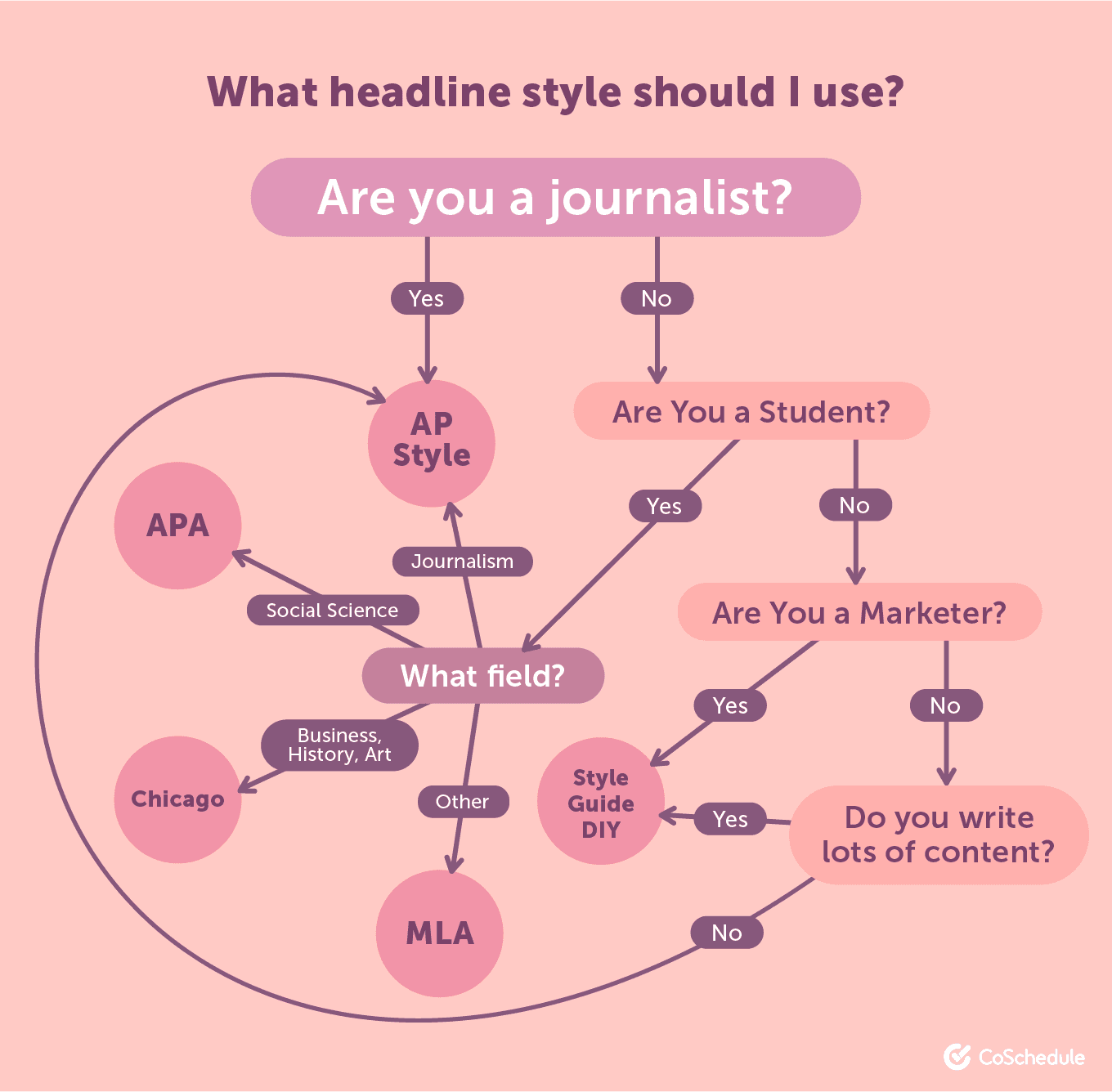
In addition to giving you some great tips on headline capitalization, here are some trustworthy, multi-faceted headline capitalization tools.
Headline Capitalization Tool
The
Headline Capitalization Tool is available for free online, and it’s the perfect tool for writing headlines when you are unsure of how the format should look within your chosen style.
This tool offers APA, AP, Chicago, and MLA headline capitalization; all you need to do is type your headline in and let the automation do the rest.
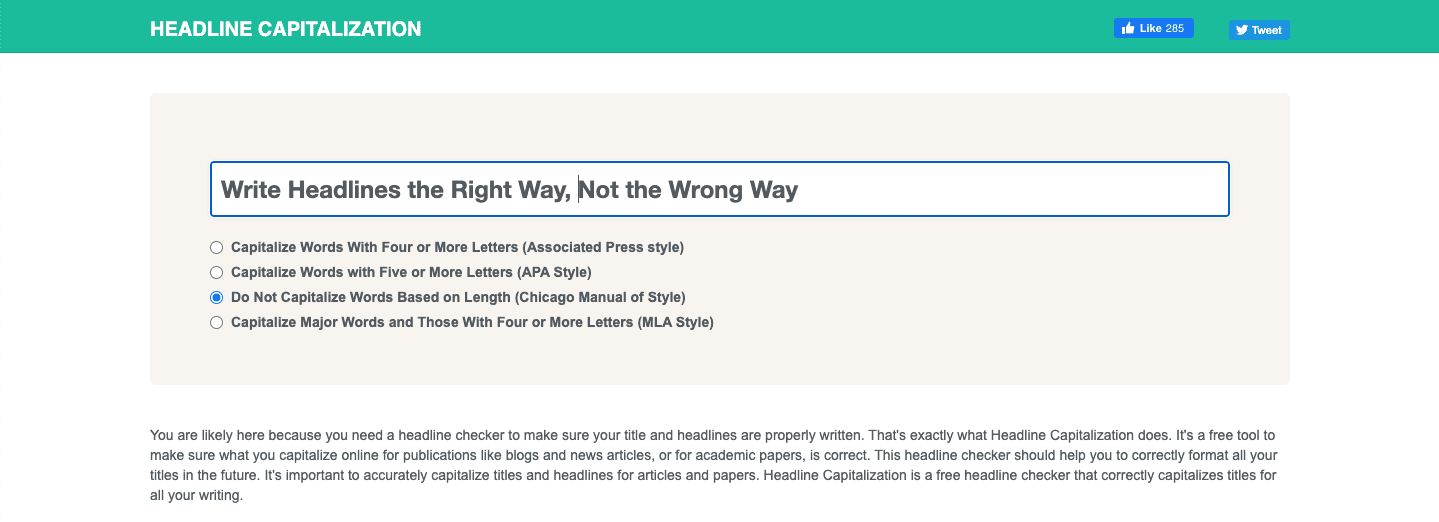
CoSchedule’s Headline Analyzer Studio:
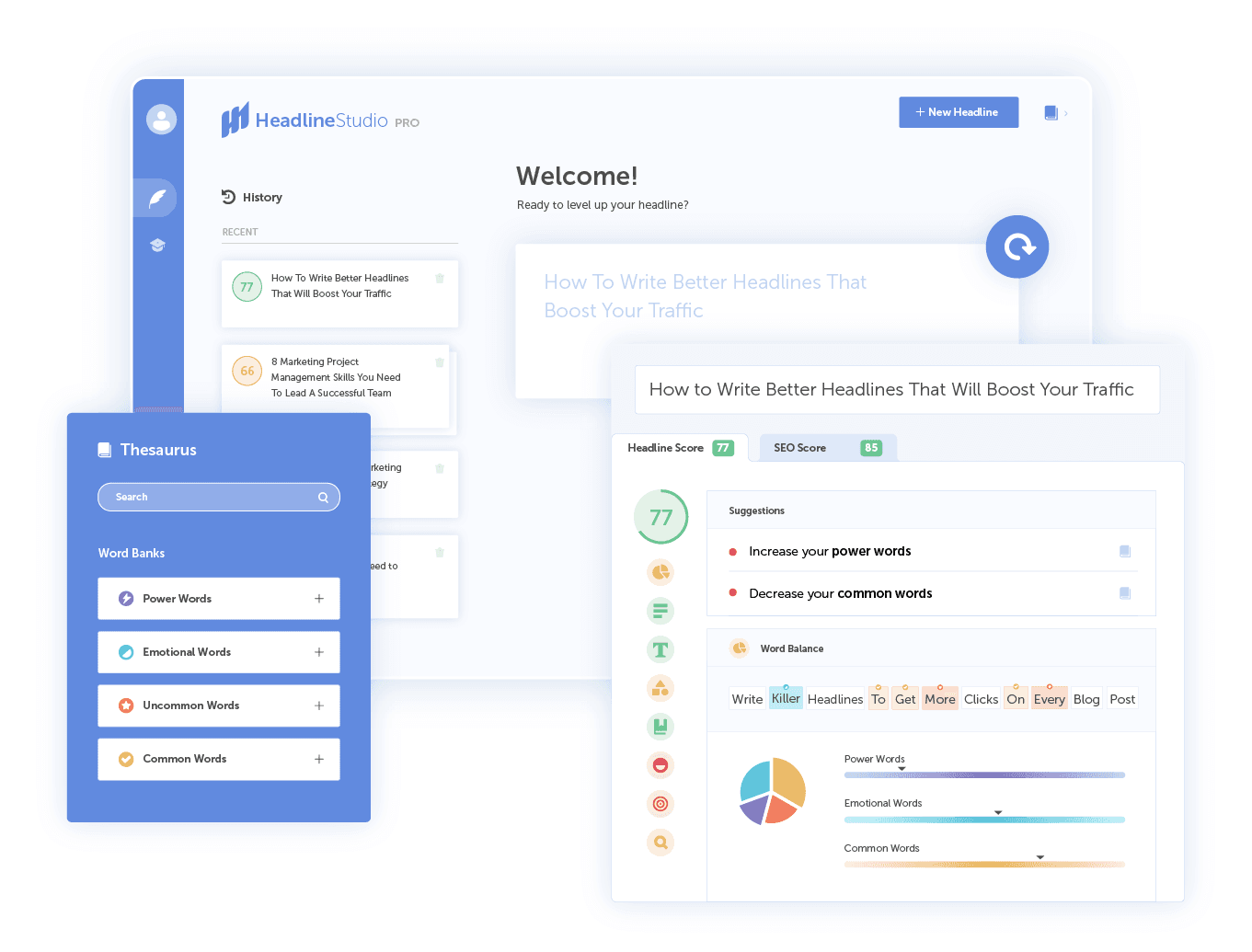 Headline Analyzer Studio
Headline Analyzer Studio gives you a headline score based on millions of headlines and suggests ways to improve your headline. This powerful tool makes writing headlines a much easier process and provides peace of mind — knowing that your headline is backed by the best data.
Try typing a few different versions of your headline and see how high you can get your score by following the recommendations!
MOZ SEO Title Tag Preview Tool:
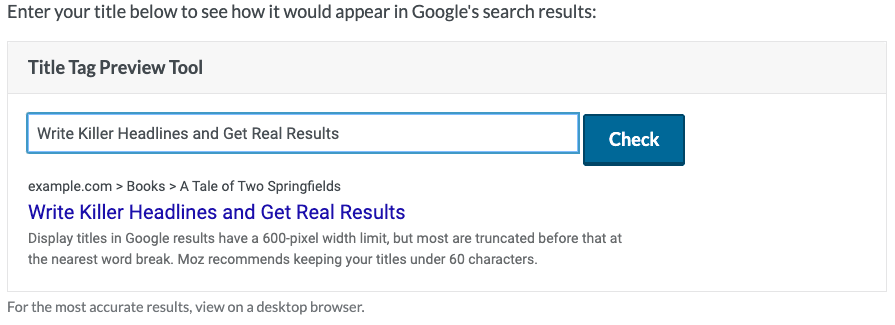
This
SEO title tag preview tool is vital for digital marketers, as it offers a preview of how your headline will look in search results if you use it as your title tag. Title tags are important for SEO, social sharing, and usability, and being able to visualize how your title tag will look in search results is important because that is the text that will decide whether people click on your content or not.
Wrapping Up
In this post, we’ve covered headline writing styles, basic capitalization principles, cases, and some powerful tools for writing great headlines and headings on your own.
The most important thing to remember is not any of the specifics of different headline writing styles, but that consistency is the key to effective headlines. Pick a style, tailor it to your audience, put it down in writing, and then use that guide to inform all of your future headlines. This will enable consistency and cohesion throughout your content, allowing easy understanding for your readers.
Now, go out and write some awesome headlines. Your audience is waiting! When I worked as a journalist, one of the hardest things I had to do throughout the entire writing process was write headlines and headings. Not only did I struggle with crafting a headline that would get readers interested in my article — which is hard enough — but I couldn’t remember proper AP headline capitalization to save my life.
Fortunately, I had patient editors who were willing to work with me to help me understand and remember how to write quality headlines every time.
Some people, however, are not so lucky, which is why I’ve written this complete guide to headline capitalization — including headline writing styles, basic headline capitalization principles, and some great tools we use at CoSchedule to write great headlines that convert and get clicks.
Let’s get started!
When I worked as a journalist, one of the hardest things I had to do throughout the entire writing process was write headlines and headings. Not only did I struggle with crafting a headline that would get readers interested in my article — which is hard enough — but I couldn’t remember proper AP headline capitalization to save my life.
Fortunately, I had patient editors who were willing to work with me to help me understand and remember how to write quality headlines every time.
Some people, however, are not so lucky, which is why I’ve written this complete guide to headline capitalization — including headline writing styles, basic headline capitalization principles, and some great tools we use at CoSchedule to write great headlines that convert and get clicks.
Let’s get started!

 Title case headline examples:
Title case headline examples:
 In addition, the following words should be capitalized under title case:
In addition, the following words should be capitalized under title case:


 Headline Analyzer Studio gives you a headline score based on millions of headlines and suggests ways to improve your headline. This powerful tool makes writing headlines a much easier process and provides peace of mind — knowing that your headline is backed by the best data.
Try typing a few different versions of your headline and see how high you can get your score by following the recommendations!
Headline Analyzer Studio gives you a headline score based on millions of headlines and suggests ways to improve your headline. This powerful tool makes writing headlines a much easier process and provides peace of mind — knowing that your headline is backed by the best data.
Try typing a few different versions of your headline and see how high you can get your score by following the recommendations!
 This SEO title tag preview tool is vital for digital marketers, as it offers a preview of how your headline will look in search results if you use it as your title tag. Title tags are important for SEO, social sharing, and usability, and being able to visualize how your title tag will look in search results is important because that is the text that will decide whether people click on your content or not.
This SEO title tag preview tool is vital for digital marketers, as it offers a preview of how your headline will look in search results if you use it as your title tag. Title tags are important for SEO, social sharing, and usability, and being able to visualize how your title tag will look in search results is important because that is the text that will decide whether people click on your content or not.


